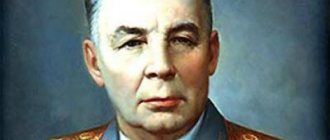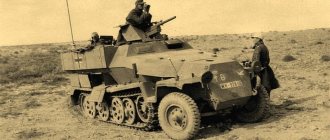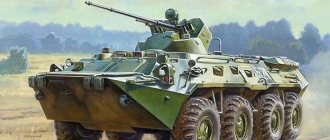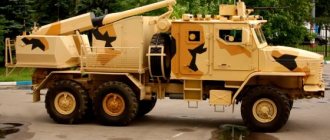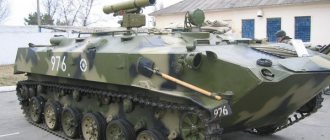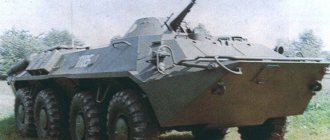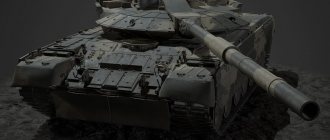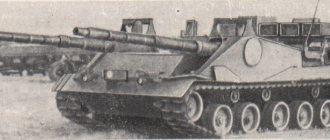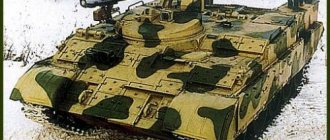History of the creation of the BTR-60
After the Great Patriotic War, the main armored personnel carrier of the Soviet Army was the BTR-152. This machine was created in 1947 and was produced until 1962. This armored personnel carrier was created in a short time, since it was based on the ZIS-151 truck. Although the BTR-152 had acceptable qualities for a vehicle created on the basis of a three-axle truck, the military still repeatedly expressed dissatisfaction that the vehicle could not move with tanks and overcome trenches.
To increase cross-country ability, the designers had to develop a new wheel formula with a uniform arrangement of axles. The first prototype of the BTR-E152V, which has an 8x8 wheel arrangement, proved that this concept works. But the handling of the new model was too low, which forced the designers to make the two front pairs of wheels controllable.
The development of a new military vehicle, the development of which was entrusted to the Gorky Automobile Plant, began in 1956. Dedkov was appointed responsible for the development of the new machine. The first prototype was ready within two years. The first version of the BTR-60 had the same design as the production model, but had a different engine.
Initially, it was decided to install one GAZ-40P carburetor engine developing 90 hp on the prototype. Operation of the first BTR-60 showed that this engine was too weak for a ten-ton armored personnel carrier. First, it was decided to install a powerful diesel engine YaAZ-206B on the armored personnel carrier, which developed 205 hp. This attempt was unsuccessful, since the heavy diesel engine did not allow the armored personnel carrier to float. There were no other options, and the designers decided to install two GAZ-40P engines on the BTR-60.
Now the armored personnel carrier has received a sufficient reserve of power, and the BTR-60 transfer case, with a reduction stage, and self-locking differentials of the combat vehicle ensure excellent cross-country ability in off-road conditions.
What can be concluded?
The BTR-60 is a legendary armored personnel carrier that is in demand on all continents. Over the entire period of serial production, from 10 to 25 thousand copies rolled off the assembly line (there is no exact information with documentary evidence). On the basis of factory equipment, engineers in different countries created numerous modifications. They are designed to perform different tasks and are still in use today.
Limited slip differential technology is now used not only for military purposes, but also for civilian purposes. The 60th model became the basis for future generations.
Serial production of BTR-60
Production of the BTR-60 was put on the assembly line in 1960. Although it was initially planned to produce military equipment of this model at several enterprises, in the end only the Gorky Automobile Plant remained the only manufacturer in the USSR. After some time, the armored personnel carrier underwent modernization:
- Night vision devices were installed;
- The crew commander received a panoramic type viewing device;
- The combat vehicle received an armored roof, which completely covered the armored personnel carrier.
Initially, it was not planned to make completely enclosed combat vehicles, but a military operation in Hungary in 1956 showed that in street battles, armored personnel carriers without a roof suffered huge losses from grenades and Molotov cocktails, which were thrown at them by rebels from the upper floors of buildings.
The second reason for the appearance of completely closed armored personnel carriers was the development of nuclear technology. Since nuclear war seemed quite likely at that time, motorized riflemen could not operate in conditions of radioactive contamination, so they could fire from under the armor. Although this limited the capabilities of the infantry, the advantages in protecting closed vehicles were obvious, so it was decided to completely switch to the production of closed vehicles.
Modification of BTR-60PB
In 1966, a major modernization of the combat vehicle was carried out. The improved model received the BTR-60PB index and the following design changes:
- A turret from BDRM-2 with a 14.5 mm KPVT heavy machine gun and a 7.62 mm PKT machine gun was installed. This significantly increased the combat power of the armored personnel carrier, moving it into a more effective class of military equipment;
- The number of troops transported was reduced to 8 people, one of whom was supposed to serve as a shooter in the turret;
- Additional surveillance devices appeared;
- The troop compartment now has hatches suitable for quick landing or disembarkation;
- Frontal protection has been slightly strengthened;
- Anti-nuclear protection has been strengthened.
The new modification of the BTR-60PB turned out to be the most successful version of the BTR-60 armored personnel carrier. They were produced unchanged until 1976. The BTR-60 differential lock showed good performance during operation, so it was left unchanged. There is evidence that the BTR-60PB was produced at plants other than GAZ until 1987. Western sources claim that in total about 25,000 BTR-60 and BTR-60PB were produced in the USSR. These armored personnel carriers are still used in many armies around the world.
Design and equipment of the Soviet combat vehicle
The hull protection of the BTR-60 is quite weak. It can protect against fragments of grenades and bullets fired from a machine gun, but a heavy machine gun can easily penetrate it. The steel sheets are only 5-9 mm thick. During the war in Afghanistan, soldiers quickly realized that hiding inside the hull of the BTR-60 was not worth it. If the car was blown up by a mine, then there was little chance of survival.
The hull itself was made in a streamlined shape, which made it easier for the armored personnel carrier to move in water. The BTR-60PB modification received a completely enclosed body with radiation protection. To protect against the penetration of dirty air, a special filter unit was used. The captain and mechanic are located in the front, the paratroopers are in the middle, and the engines and transmission are located in the rear.
The BRR-60PB received a cone-shaped turret. It had the same weak armor as the hull. The shooter was placed in a turret, which rotated using a special screw mechanism.
As for the armament of the armored personnel carrier, the basic modification had only three SGBM machine guns. After several minor modifications, it was decided to replace these machine guns with more advanced PCBs. The BTR-60PB modification received a more serious weapon - a 14.5 mm KPVT heavy machine gun. With such weapons, the BTR-60 could easily deal with lightly armored enemy vehicles. In addition to machine guns, grenades were used as additional weapons, of which there was an impressive supply.
Screw mechanisms were used for aiming at the target, and a periscope-type optical sight was used for aiming. If a large-caliber machine gun was used for lightly armored vehicles, then the PKB was usually fired at living targets located within a radius of up to 1,500 meters.
To monitor the terrain in the BTR-60, the following devices were used:
- B-1 in the amount of 6 pieces was installed on copies of the first issues;
- After some time, the captain of the armored personnel carrier received the TPKU-2B device;
- TVN-1 and TVN-2 were devices for monitoring terrain in conditions of limited visibility.
In addition, to view the area in a calm situation, two inspection hatches located in the frontal part of the vehicle were used.
Compared to foreign analogues
The Soviet armored personnel carrier BTR-60 is much larger in size and less armored than its foreign counterparts. But if you make the armor of the BTR-60 thicker, the protective performance of the vehicle will naturally increase, as will the weight of the vehicle. But it will no longer be able to swim, and the power of the water-jet propulsion is not enough to move the armored personnel carrier through the water. At that time, only the American Marine vehicle LVTP-5 could sail in the world, but it developed a speed on water that was half that of the BTR-60.
For all foreign armored vehicles of that time, landings were carried out under the protection of the armor of an armored personnel carrier.
This happened due to special ramps and hatches provided in the rear of the vehicle. The Soviet infantrymen ran out of the BTR-60P from the landing squad through special doors located on the side of the hull, and they had to straighten up to their full height. Which, from a tactical point of view, is, to put it mildly, unprofitable.
The situation with dismounting infantry was worse only in the modification of the BTR-60PA, where landing took place only through the upper hatches. Here, the soldiers climbing out of an armored vehicle that was still moving looked more like tankers escaping from a damaged tank than warriors preparing to attack.
Motor and transmission BTR-60
The BTR-60 used an interesting engine installation scheme. Since the heavy vehicle could not move quickly with one GAZ-40P engine, it was decided to install two. In total, these two engines are capable of developing 180 hp. The right engine is responsible for the operation of the first and third axles, and the left one is responsible for the operation of the second and fourth. It is possible to turn off one of the engines and move only due to the operation of the second. Each engine has a separate fuel tank. Additional functions of the engines include the operation of a water jet and a winch from them.
The BTR-60 is equipped with a “dry” single-disc clutch. To make it easier to work with, it was decided to use a hydraulic drive. The gearbox is four-speed. Due to the power take-off shaft, it switches to a water jet. The two main gears of the BTR-60 include self-locking differentials.
Currently, the BTR-60 differential lock is often installed on UAZ by fans of extreme tuning. The BTR-60 self-block ensures uniform wheel speed on all axles of the combat vehicle. The armored personnel carrier is capable of moving even if one of the engines fails completely.
Performance characteristics
| Parameter name | Index |
| Booking, mm: | |
| – forehead of the body; | 7-11 |
| – board; | 7 |
| – feed; | 5-7 |
| – tower; | 7 |
| – bottom; | 5 |
| - roof. | 7 |
| Wheel formula | 8 × 8 |
| Gross weight, t | 10,3 |
| Overall dimensions, m: | |
| - length; | 7,56 |
| - width; | 2,83 |
| – height along the roof of the building. | 2,42 |
| Engines: | |
| – type and model; | two GAZ-49, 6-cylinder, carburetor, in-line, liquid cooling |
| – power. | total power 180 (2×90) hp. at 3600 rpm |
| Number of seats for combat crew, people. | 10 |
| Maximum speed, km/h: | |
| – by land; | 80 |
| - afloat. | 9 |
| Chassis | Tire size 13.00-18″, tire air pressure is adjustable from 0.5 to 2.5 kg/cm 2 , independent torsion bar suspension, hydraulic shock absorbers, telescopic, double acting, two each for the wheels of the 1st and 4th axles and one each for the wheels of the 2nd and 3rd axles, wheels of the 1st and 2nd axles managed |
| Winch length, m | 50 |
| Ultimate traction force, kgf | 4500 |
| Ground clearance at full load, mm | 475 |
| Power reserve: | |
| – by land, km | 500 |
| – afloat, hours | 12 |
| Obstacles to be overcome: | |
| – elevation angle, degrees | 30 |
| – ditch width, m | 2 |
| – wall height, m | 0,5 |
Chassis and water cannon BTR-60
When creating an armored personnel carrier, an 8x8 wheel arrangement was used. Since the controllability of the prototype with traditional steering was insufficient, it was decided to make the two front axles steerable. The design of single-ply tires allows them to withstand a bullet hit. Two compressors are capable of inflating tires remotely. This helps not only to move with a broken tire, but also to change the pressure depending on the type of terrain.
The wheels are located on two levers connected to the body by hinges. Each upper arm, except the third axis, has two hydraulic shock absorbers. The BTR-60's suspension is independent, torsion bar. An armored personnel carrier can continue to move even if two wheels are completely lost.
The water jet device of the armored personnel carrier is powered by GAZ-40P engines. It is located under the motor and has a propeller. To prevent the propeller from being damaged, it was covered with a grille on one side and an armored flap on the other.
The BTR-60 and its modifications have proven themselves in most combat conflicts of the 20th century. Because the Soviet Union helped developing countries, these armored personnel carriers can now be found in the armies of developing countries around the world.
general information
The 60th model became the first four-axle armored personnel carrier. The development of the line of this equipment continues in our years. For 16 years (1960-1976) it was produced at the Gorky Automobile Plant. Until 1987, the Kurgan plant of wheeled tractors was producing. Another production point was located in Romania. Local specialists assembled equipment under Soviet license (TAV-71).
Until the end of the 60s, the BTR-60 was the main all-terrain vehicle in the Soviet army. In the 70-80s, the number in the army decreased significantly due to the release of the 70 and 80 models. The vehicle went through many combat operations, including the Afghan War. Exports were carried out to dozens of countries around the world. Despite its impressive age, the equipment operates in the army units of 47 countries (data for 2007).
Nowadays, the BTR-60 blocking technology is popular. The most common application is the introduction into the design of UAZ vehicle bridges. In many online stores you can buy a BTR-60 lock, both new and old. It’s difficult to talk about the difference in quality; everyone finds certain advantages for themselves. The average cost for civilian transport is 8-12 thousand rubles, for military transport - up to 19,500.
